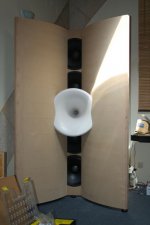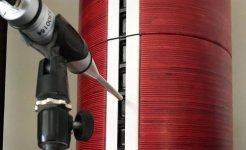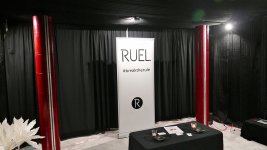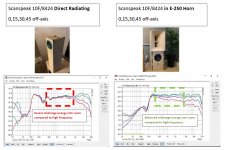I think the arrays can get you to where you want to go too.
My experience matches in with most of what I have read from a number of different sources that lateral reflections that occur within 6ms of the direct sound are the ones than are likely to cause timbral degradation. As these are fused with the direct sound and cannot be separated as separate events like the ear can do with later arriving reflections. Avoiding those can be achieved by having more than 1 metre distance to any reflecting surface making the overall path length difference 6ms plus. Full range arrays need to be closer to the front wall for reinforcement 50cm from wall to front baffle has always worked the best for me for the uniformity of response below 200Hz.
In your setup that is not so practical so you are left with directivity or absorption to deal with them. Which is where your original idea stemmed from.
If your main musical listening is to classical, jazz and acoustic styles then I would advise against too much damping overall as these are the types of music that are much more tolerant of reflections and can often benefit from them (still trying to avoid the sub 6ms ones).
Using the ambience channels for an artifical Haas kicker is another way to inject back some of that room sound while also making it controllable. Maybe you have the space to make that work worth thinking about at least.
You may be able to make a free standing array and place it further out from the bookcase to peek out much like wesayso has done from his right hand niche, you could then meaure in situ and damp the areas that need attention. Angling the speakers to point directly at the listening position can have a beneficial effect in that the direct sound field is stronger that way and you benefit from the natural drop of of the TC9 at offaxis angles. 75mm fibreglass of medium density with 10mm felt over the top and an air gap behind is a pretty good panel for reflection control at least down to 500Hz. Making the panels only as wide as is needed to control the reflection can also help to avoid making the room overly dead, they do need to be full height with an array to have maximum effectiveness. From my own experience a few panels in strategic positions makes things quieter and more controlled without making the room feel uncomfortable or dead.
Thanks for lots of good info! I probably have to stick to the idea of having the arrays in the corners, so there will inevitably be some very early reflections to deal with. And then, this is a living room - so I definitely don’t want to create a “dead” space. 🙂
Absorbing panels behind both curtains. About 3 inch in thickness with an airgap between panel and wall. Wool felt top layer over fluffy fiberglass insulation material.
I'll post my thoughts later today after work. With virtual Haas kickers/ambient speakers you get to pick the time delay you want/need. The room return (or in this case ambient speakers) should be diffuse in nature and decorrelated from mains.
Read up on some David Griesinger papers to get a feel of what it is you want. Highly recommended reading. He was the one behind the well known Lexicon reverbs.
Thanks for the info and reading tip! I will check it out! 🙂
Yes, I do have a plan for ambient speakers as well as experimenting with mid-side EQ as you did. 🙂
Dear Squeak,
It seems you totally missed the point of my post, didnt you? No single reaction to my suggestion that anyone besides Toole could also have a valid opinion. I even presented a couple to you. As said, I can list more, even valued members of this industry. In my book, they can all have valid opinions as much as Toole's opinion.
I know Toole is not dogmatic about it, but you are. I'm done here if you don't actually read my posts and try to grasp what it is I say nor read any of the links I provide.
Nor are you willing to read up where my own opinion came from. There's a whole thread of information should you be interested in that some time later.
Now if you don't mind, and even if you do, I'll go answer more important questions in this thread than your endless debate about Toole and his findings, which most of us are well aware of without you mentioning him in nearly every post you make. That much of a fan huh? 🙂
Should that not be a satisfactory way of ending our conversation for you, I'll neglect to react until you read up on what I did and why, you can do so here: The making of: The Two Towers (a 25 driver Full Range line array)
If you had done that reading prior to just assuming what any of us knows you'd be aware that I don't put Toole aside in any way, nor the late great Linkwitz. You'll see a lot of other research and names pass as well, that I value equally as much.
If you call this a discussion, your opinion of a discussion is rather different than mine. You do not react to, or read my words, you are picking out parts of it and jump to ill conclusions without really being informed.
Do you want more line array theory? There's more than one link in the first post of my thread. I do not bend any laws of physics, I just make good use of them.
P.S. did you somehow miss that I have read Toole and value his opinion, even though I came to a different conclusion on certain subjects in my environment? One can never know if typing this for the nth time it may hit home 😀.
**Contrary to Toole I have never been in the business to sell speakers. I may have caused a boost in the sales of the Vifa TC9 FD18-08 though 😀.**
It seems you totally missed the point of my post, didnt you? No single reaction to my suggestion that anyone besides Toole could also have a valid opinion. I even presented a couple to you. As said, I can list more, even valued members of this industry. In my book, they can all have valid opinions as much as Toole's opinion.
I know Toole is not dogmatic about it, but you are. I'm done here if you don't actually read my posts and try to grasp what it is I say nor read any of the links I provide.
Nor are you willing to read up where my own opinion came from. There's a whole thread of information should you be interested in that some time later.
Now if you don't mind, and even if you do, I'll go answer more important questions in this thread than your endless debate about Toole and his findings, which most of us are well aware of without you mentioning him in nearly every post you make. That much of a fan huh? 🙂
Should that not be a satisfactory way of ending our conversation for you, I'll neglect to react until you read up on what I did and why, you can do so here: The making of: The Two Towers (a 25 driver Full Range line array)
If you had done that reading prior to just assuming what any of us knows you'd be aware that I don't put Toole aside in any way, nor the late great Linkwitz. You'll see a lot of other research and names pass as well, that I value equally as much.
If you call this a discussion, your opinion of a discussion is rather different than mine. You do not react to, or read my words, you are picking out parts of it and jump to ill conclusions without really being informed.
Do you want more line array theory? There's more than one link in the first post of my thread. I do not bend any laws of physics, I just make good use of them.
P.S. did you somehow miss that I have read Toole and value his opinion, even though I came to a different conclusion on certain subjects in my environment? One can never know if typing this for the nth time it may hit home 😀.
**Contrary to Toole I have never been in the business to sell speakers. I may have caused a boost in the sales of the Vifa TC9 FD18-08 though 😀.**
Thanks for lots of good info! I probably have to stick to the idea of having the arrays in the corners, so there will inevitably be some very early reflections to deal with. And then, this is a living room - so I definitely don’t want to create a “dead” space. 🙂
There's not much chance of creating a dead space if you'd only target the first reflections with arrays. They will still react with the room, create enough diffuse energy which almost makes it almost impossible to make it sound that dead.
Fluid already said a lot of what I wanted to say. For instance if it is an option to make the arrays free standing you can do some placement experiments that might give an advantage. Placing the baffle just in front of that bookshelf may be such an advantage. You also get a chance to play with a little (and even a lot of) toe in, see what you like best.
Thanks for the info and reading tip! I will check it out! 🙂
Yes, I do have a plan for ambient speakers as well as experimenting with mid-side EQ as you did. 🙂
No problem, I'd rather respond to get you going than the side attraction I felt I was experiencing/feeling here 🙄. That leads nowhere if you ask me.
An idea for ambient channels would be to use dipole's. Aiming their nul at the listening spot so almost all you get to hear is their reflected energy.
Another way is to aim them at the ceiling, much like what Linkwitz did here: Surround stereo system
In part two of that page he wrote about ambience recovery. Even Linkwitz points towards Griesinger as a reference. I just picked that reference up from fellow members here some time long ago, probably from reading Geddes.
(I'll confess: I've used the search function and actually literally read all of Geddes posts, even before I started building my arrays. Not a valuable confession as I've mentioned it before. I've spend a year and a half of research before building. I also read Linkwitz at that time as my first interest was dipoles.)
If I look at your picture, placing the lines in both corners beside the bookshelf means a lot of symmetry in setup. This may mean that nulls from both speakers due to in room placement might actually line up a little too good. (in other words, they happen at similar frequencies)
My space is way more asymmetric as far as placement goes. That allowed me more freedom of getting a good sum from left + right channel below ~80 Hz. Be prepared to use extra help on the bottom end if the symmetry is working against you here. With my added subwoofers I was able to let those pickup where the arrays were causing a null due to their placement.
I also like the idea from Joseph, if applicable to a full line (like fluid also suggested). I have seen him post about the results he got with the 10F and it is intriguing. I can't say if you could fit something like that. The waveguide would end somewhere.
I'd picture it looking something like this, only way smaller, more drivers and without the central horn:
BDDesign
A shallow slith opening has been used before on arrays:
Ruel R+
But there's no waveguide on that one. Tiny drivers huh? 🙂
Both of these solutions that I mention here fall into the 'diffraction slot' category though. I would not start building it like that unless some previous experiments proved to be successful.
Maybe Joseph has some more info on his experiments somewhere? All I had seen was waveguide vs no waveguide plots, not the actual horn. I haven't looked for it though.
Attachments
What does a your horn look like? It would be interesting if it could be made to work with a full line of drivers, the TC9's crumboo has are not wildly different to the scanspeak drivers.
It's the E-250 Front Horn which is available as plans to download. The madisound Thiel 10F/8424G02 are not longer available so it would need to be the standard version (10F/8424G00) or something similar. Distortion on the 10F is lower than even the BG Neo8 in the same horn.
E-250 Front Horn 3D CAD Files + Drawings – Joseph Crowe
So here are some very preliminary measurements. One driver attached to a crude open baffle just to have a look. For the next measurements I will attach some box on the back side of the baffle. But still maybe som conclusions can be made from these first measurements. All measurements are done in the same spot (listening position).
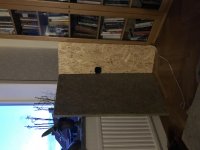
First, impulse response without any absorbers at all:
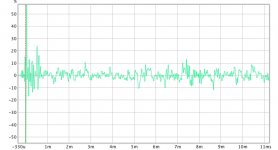
Some pretty strong very early reflections (< 1 ms).
Next, 45 mm absorber against the left wall (as in the above picture):
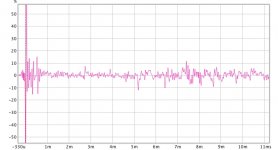
Reduced level of reflections up to about 6 ms.
Now, like above but with absorber on the baffle to the right of the driver:
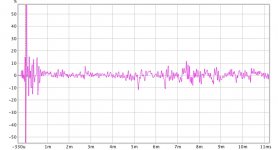
Not much of a difference.
Then, turn the right absorber so that absorbers form a V-shape with the driver in center:
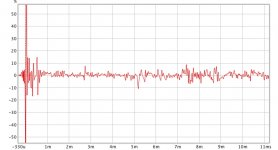
Some reduction of reflections above 7 ms.
Lastly, frequency plots of the above (with separation), with 1/12 smoothing:
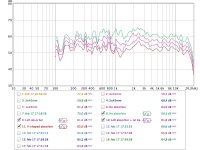
And the same with 4 cycle FDW:
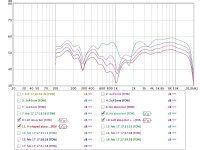
Why the big dips in the response? The dip at 285 Hz may be due to destructive interference from the backside of the driver I guess. The other dip seems to move when the absorber on the left is added...
I will not draw much conclusions of this yet, more testing is needed (with a closed box!). Absorption on the wall seems as a good thing with respect to the impulse plots tough. Next I will try with a double layer of absorbers (90 mm) to see what difference it could make, if any. Since it's only one driver on the baffle there is probably some reflections from the ceiling in these measurements as well (I put some absorbers on the floor between the mic and speaker in order to reduce floor reflections).

First, impulse response without any absorbers at all:

Some pretty strong very early reflections (< 1 ms).
Next, 45 mm absorber against the left wall (as in the above picture):

Reduced level of reflections up to about 6 ms.
Now, like above but with absorber on the baffle to the right of the driver:

Not much of a difference.
Then, turn the right absorber so that absorbers form a V-shape with the driver in center:

Some reduction of reflections above 7 ms.
Lastly, frequency plots of the above (with separation), with 1/12 smoothing:

And the same with 4 cycle FDW:

Why the big dips in the response? The dip at 285 Hz may be due to destructive interference from the backside of the driver I guess. The other dip seems to move when the absorber on the left is added...
I will not draw much conclusions of this yet, more testing is needed (with a closed box!). Absorption on the wall seems as a good thing with respect to the impulse plots tough. Next I will try with a double layer of absorbers (90 mm) to see what difference it could make, if any. Since it's only one driver on the baffle there is probably some reflections from the ceiling in these measurements as well (I put some absorbers on the floor between the mic and speaker in order to reduce floor reflections).
Build the lines - then experiment with damping, horn... etc..
You will have a really hard time making anything out of these test vs how the lines will behave. Still, it could be fun!
Please use the "upload" function to add pictures - much easier to read for us 😉 (-> Go Advanced, Manage Attachments. You will get links to the uploads so that you can refer to any, if you like)
//
You will have a really hard time making anything out of these test vs how the lines will behave. Still, it could be fun!
Please use the "upload" function to add pictures - much easier to read for us 😉 (-> Go Advanced, Manage Attachments. You will get links to the uploads so that you can refer to any, if you like)
//
It's commendable that you want to see where you went wrong but to avoid cluttering this thread even more I don't think it serves Crumboo's purpose to rehash it. Look at the responses where someone bit back at you, they read something in your words that upset them enough to do that.Please point to places where my tone has been harsh or aggressive, and I'll try to better myself from those examples.
Raising hackles to a certain degree is one of the main reasons for forums. If it was just a big echo chamber and list of references, it would all be a bit pointless. No?
Disagreement and misunderstanding is not fighting. At least among reasonably civilised people.
I don't think raising hackles is the point of this forum, spirited debates occur and can be informative and sometimes amusing to watch from the sidelines, but the overall aim is to share knowledge and to help.
I must not have been clear in my explanation if you think I am trying to create a straw man, I was in fact trying to do the opposite. What you say in the rest of this comment is pretty much what I was trying to convey i.e. there is more to it and it is best explained by the man himself in his latest book.Toole has never been dogmatic or put out credos. Neither have I in this thread. You are building straw men.
I have the book right here in front of me. And the small article is not, not representative of his views. Of course you get a lot more answers and food for thought in the book, but the article is not a bad starting point.
No they are not just as every speaker is a compromise, you have to pick the ones that make the most sense to you.They are not without problems, and I don't think they are for me. But I can sure hear they have some quite magical things going for them, from the few encounters I've had with them.
Due to the length of the line and the directivity created by it sidewall reflections affect the entire height of the room, with a standard speaker a reflection could be absorbed well enough with a panel at ear height, with the lack of floor and ceiling reflections from a full height line the side wall reflections are more exposed, I think these are the reasons.I can't see how sidewall reflections should be any more pronounced or fundamentally different than with "normal" speakers.
If I'm mistaken, enlighten me.
I'm not really saying that either, but some speakers do in fact complement or detract from certain genres due to their directivity patterns and room interaction. It is not possible to get something that works equally well for all styles but certainly the better the speaker is designed to work with the room it is put in the closer to that ideal you will be.I don't really buy the notion that some genres or types of recording should call for different speakers.
Demands on dynamic range is a different matter altogether. But a good speaker and setup of them, should be good for most types of recording.
Most genres include subgeneres, variation and parts where they could be said to go into another territory.
FDW will show you more of the direct sound where the overall non windowed response will show you how the reflections fill in those gaps. To see the reason why look at the spectrogram in REW to see the response change over time or use the filtered IR to see what is happening to the reflections at different frequencies, as a plain IR or full band ETC will be dominated by high frequencies.Why the big dips in the response? The dip at 285 Hz may be due to destructive interference from the backside of the driver I guess. The other dip seems to move when the absorber on the left is added...
It's commendable that you want to see where you went wrong but to avoid cluttering this thread even more I don't think it serves Crumboo's purpose to rehash it. Look at the responses where someone bit back at you, they read something in your words that upset them enough to do that.
Glancing back through the thread, I see where I might have inadvertently insulted Koldby personally and Wesaysos speaker setup indirectly too.
Perceval is still a mystery though.
What I meant with my comment to Koldby was basically a repetition of the old cliche that everybody thinks they are immune to visual bias, proud papa syndrome and the "that's-way-it's-supposed-to-be-done, therefore it must sound better".
Again, its a cliché, but it happens to everyone in small and big ways.
The only real way to avoid it is extensive measuring AND double blind testing with a large enough group.
Not only did Koldby take it personally I think, he also thought I implied that his experience with Wesaysos setup was unimportant or piddly.
Not so.
I'm sure both setups are stunning and well considered for their respective rooms.
I don't think raising hackles is the point of this forum, spirited debates occur and can be informative and sometimes amusing to watch from the sidelines, but the overall aim is to share knowledge and to help.
Potato/karate. Raising hackles/spirited debate. 🙂
Due to the length of the line and the directivity created by it sidewall reflections affect the entire height of the room, with a standard speaker a reflection could be absorbed well enough with a panel at ear height, with the lack of floor and ceiling reflections from a full height line the side wall reflections are more exposed, I think these are the reasons.
So you mean floor and ceiling is out of the equation (due to natural beaming and due to the fact that you actually want reflection there is, to simulate an infinite array) and that makes the sides more dominant? Makes sense.
But the sides are always dominant with drivers at ear height.
The rest is just scaling evenly AFAICS. IE number of driver and sidewall reflection.
Last edited:
Dear Squeak,
It seems you totally missed the point of my post, didnt you? No single reaction to my suggestion that anyone besides Toole could also have a valid opinion. I even presented a couple to you. As said, I can list more, even valued members of this industry. In my book, they can all have valid opinions as much as Toole's opinion.
No, sense in getting overbearing now.
What you are suggesting is so absolutely a truism that I found it meaningless to reply to.
I keep mentioning Toole because, A. He comes up a lot WRT this topic. B. You keep mentioning him, so why not keep it simple?
I know Toole is not dogmatic about it, but you are. I'm done here if you don't actually read my posts and try to grasp what it is I say nor read any of the links I provide.
Nor are you willing to read up where my own opinion came from. There's a whole thread of information should you be interested in that some time later.
Nice to know.
I have read a lot of your thread through the years, and the links. While clearly interesting, there is nothing new as such in them, or something conclusive pertaining the topics discussed here.
Now if you don't mind, and even if you do, I'll go answer more important questions in this thread than your endless debate about Toole and his findings, which most of us are well aware of without you mentioning him in nearly every post you make. That much of a fan huh? 🙂
Again, this was mainly for the benefit of the original poster, who I think thought it was nice to know.
If you call this a discussion, your opinion of a discussion is rather different than mine. You do not react to, or read my words, you are picking out parts of it and jump to ill conclusions without really being informed.
No, you are right this is not a discussion. More like a misunderstanding.
P.S. did you somehow miss that I have read Toole and value his opinion, even though I came to a different conclusion on certain subjects in my environment? One can never know if typing this for the nth time it may hit home 😀.
I think we can agree that this thread is not really about you or me. Or our egos. But how we can inform Crumboo and help him. He, who is about to invest a not inconsiderable sum, and large amount of time in his speakers.
You of anyone should understand that.
Perceval is still a mystery though.
Nice try, troll.
Running out of people to pick a fight with?
I'm not biting.
Crumbo is doing a great job at avoiding the pitfalls and is willing to continue his research. Commendable. And we will follow his journey.
What I meant with my comment to Koldby was basically a repetition of the old cliche that everybody thinks they are immune to visual bias, proud papa syndrome and the "that's-way-it's-supposed-to-be-done, therefore it must sound better".
Again, its a cliché, but it happens to everyone in small and big ways.
The only real way to avoid it is extensive measuring AND double blind testing with a large enough group.
All of us will have suffered an episode of the emperors new clothes at some point, but after long term listening all of these are exposed as being incorrect it just takes longer than a blind test. Almost all double blind testing has been done on conventional speakers and line arrays behave differently enough and require different setups to respond optimally, to make the results of those tests not as easily applicable to a floor to ceiling line.
I think you can now see why they didn't really get that from your first comments 😉I'm sure both setups are stunning and well considered for their respective rooms.
Yes there are virtually no reflection effects from the floor or ceiling in a floor to ceiling line. I have measured mine both indoors and out and they are not there. So yes that is why it makes the sides more dominant.So you mean floor and ceiling is out of the equation (due to natural beaming and due to the fact that you actually want reflection there is, to simulate an infinite array) and that makes the sides more dominant? Makes sense.
But the sides are always dominant with drivers at ear height.
The rest is just scaling evenly AFAICS. IE number of driver and sidewall reflection.
Here's a comparison that illustrates what I'm referring to. I've highlighted the midrange off-axis response and how a front horn drastically alters the power response into the room which has a significant effect on the perceived tonal balance. I should note that the 10F isn't much different than a regular dome tweeter's off-axis characteristics.
Attachments
Crumboo, let's see what an enclosed driver can do. Maybe first well out of the corner away from any walls to get a base line.
Next we will look into what it does in the corner with different placement options.
Joseph: impressive! That's quite the transformation. Is that one or two drivers behind the horn?
Next we will look into what it does in the corner with different placement options.
Joseph: impressive! That's quite the transformation. Is that one or two drivers behind the horn?
Nice try, troll.
Running out of people to pick a fight with?
I'm not biting.
Crumbo is doing a great job at avoiding the pitfalls and is willing to continue his research. Commendable. And we will follow his journey.
Now you are just reverse trolling.
Why shouldn't he be willing to continue his research? Let alone what pitfalls he might have avoided, I don't see.
It's all very preliminary.
He is building a speaker. Then you need to do research.
You are stating the obvious and it smells like virtue signaling.
I can see how you can interpret it like that with some effort.I think you can now see why they didn't really get that from your first comments 😉
But Im also confused that someone so sure of their own works worth, takes perceived, left field, insinuated insult so readily.
I'll strap on my eggshell treading shoes next time.
Squeak - give it up. You are about to ruin this thread - sorry to say. Somehow I think it will do fine without your presence.
//
//
Squeak - give it up. You are about to ruin this thread - sorry to say. Somehow I think it will do fine without your presence.
//
Give what up? I'm doing more or less exactly the same thing as the guys I'm responding to. You just happen to be on their side.
What might be "ruined", is easily rectified by you starting to actually talk about linear arrays and how to build them.
There is great deal of crypto gate keeping in this threat. That would be a good thing for Crumboo to look out for.
Thanks for posting the Ruel R+. I'd seen it before but lost track of it. The diffraction slit in front of the line is something I would like to try. Except for that though, the construction looks very much like yours. So they are a way to quantify your sweat equity. I wonder though how much market there is for speakers at $50K++ per pair.
Doing a nearfield measurement on a line array is also curious. If truly nearfield, each driver's LF response would be identical so you would only need to measure one to get a quasi anechoic LF response. Hadn't thought of that; wonder how far up it would hold
Crumboo, let's see what an enclosed driver can do. Maybe first well out of the corner away from any walls to get a base line.
Next we will look into what it does in the corner with different placement options.
Joseph: impressive! That's quite the transformation. Is that one or two drivers behind the horn?
Each horn has four drivers. The rear chamber is reflex tuned just below the cutoff frequency of the horn. This controls diaphragm movement outside the horn’s pass band. There’s a 50% reduction in %THD when using the rear chamber across the lower midrange.
Subjectively it reproduces some of the best midrange I’ve heard. I’m using it from 250Hz-20Khz.
- Home
- Loudspeakers
- Full Range
- Another corner line array, 28 TC9FD18
